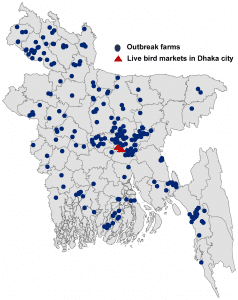

The first paper is a case report of subclinical avian influenza H5N1 virus infection in a Vietnamese household in which family members were involved in slaughtering, preparing, and consuming chickens, and birds were permitted to roam freely in the sleeping area. Four chickens from this household were found to be positive for H5N1 virus by polymerase chain reaction (PCR) of throat and cloacal swab specimens. The 40-year old father died after a severe four day respiratory illness requiring hospitalization; H5N1 viral RNA was detected by PCR of a throat swab on day 3 of illness. A throat swab from his daughter, taken 6 days after she had killed a chicken, was positive by PCR, and H5N1 virus was recovered by inoculation of cell cultures. Her hemagglutination-inhibition (HI) titer, a measure of anti-viral antibodies, increased from <20 to 160, but she showed no signs of illness, perhaps because she was treated with oseltamivir from day 5 of her father’s illness.
The authors note the difficulty in detecting subclinical H5N1 infections:
…it is unclear whether serologic testing reliably detects subclinical cases. According to the World Health Organization,MN (microneutralization) titers >80 are indicative of infection but must be confirmed by a second serologic test because of the possibility of cross-reactivity. The interpretation of results from a single serum sample is limited by the specificity or sensitivity of serologic tests, and viral shedding times may mean that infected cases may be missed.
The second study examined seroprevalence of anti-H5N1 virus antibodies in poultry workers in Bangladesh. Sera were collected in 2009 from poultry workers on farms (212 from 87 farms) and live bird markets (210 from 3 markets). Some of the farm workers (91%) reported handling sick animals during laboratory-confirmed H5N1 outbreaks. Sera were screened for antibodies to H5N1 virus by two methods: microneutralization and hemagglutination-inhibition. None of the individuals were seropositive for anti-H5N1 virus antibodies.
I have several reservations about this study. Although H5N1 virus was identified on the poultry farms whose workers were sampled, the sera were drawn from 22 to 543 days after the onset of poultry deaths. If any of the workers had been infected with H5N1 virus, anti-viral antibody titers might have already declined by this time. Although the sera were examined for anti-viral antibodies by two different tests, paired sera were not used, as recommended by the authors of the first paper discussed above.
Therefore the answer to the question ‘what is the fatality rate of influenza H5n1 virus infections in humans?’ still cannot be answered. As the authors of the first paper conclude:
Estimating the incidence of asymptomatic influenza A(H5N1) virus infection in humans exposed to sick poultry or human case-patients requires further careful study using early collection of swab samples and paired acute and convalescent serum samples.

I think there is a typo in your post–you talk about the man in the first study dying after a two day respiratory illness, but then talk about a throat swab taken on day 3, and the daughter being on an antiviral after day 5 of her father’s illness.
Right, I’ve fixed the timing; his illness lasted four days.
Kawaoka is a great hunter of virus, such as Ebola virus represented by his reseach .What motivation do you have to chase and confirm the fact of virus? Course’s lecture is going to the final exam , I ‘d like to say thank you for enlightening my mind very comfortably. I took the lectures ,called as Virology, you send me the lectures and stories without spareing your properties you have stored for many years. I took your lectures from Japan. I have a expectation to come back to Coursera as the Viorogy 2. thank you,Professor
Pingback: Band-Aid Brand Adhesive Bandages, Plus Antibiotic, Assorted, 20 Count (Pack of 2) Reviews | WWW.MY-INFOPAGES.COM
Pingback: The value of influenza aerosol transmission experiments